![]()
News
2/11/2011
 |
 |
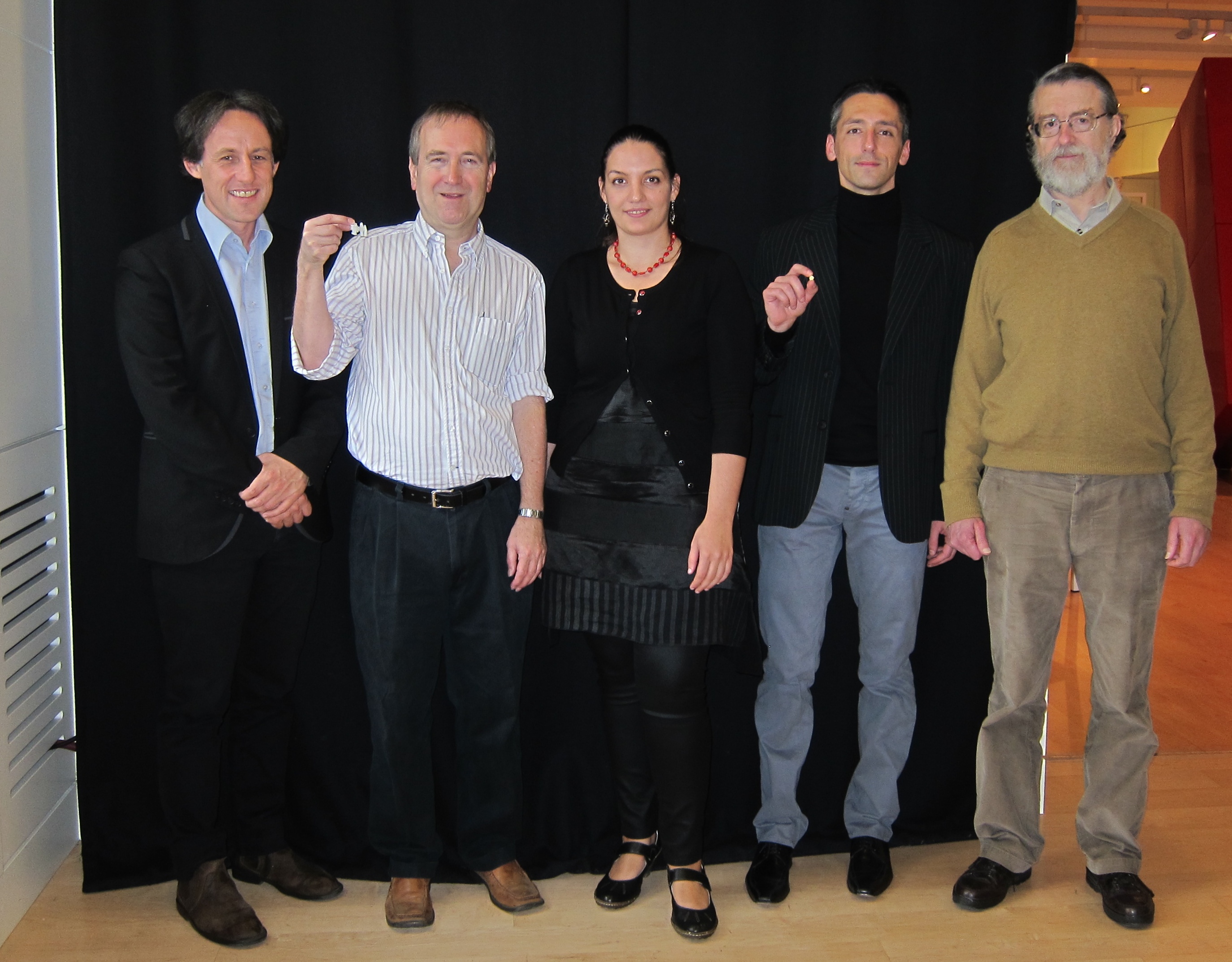 |
The KC4 maxilla, excavated in 1927 at the site of
Kent's Cavern, Devon. (Photo: Chris Collins: NHM). |
One of the Cavallo infant teeth, now identified as a
modern human. This is Cavallo B.
(Photo: S. Benazzi). |
Lead authors at the Nature
press conference for the papers in London at the Welcome Collection, 2
Nov 2011
l-r: Higham, Stringer, Douka, Benazzi, Compton. |
Nature articles on the
origins of modern humans in Europe published
Members of the Unit have led two articles published in the journal Nature. Tom Higham was lead
author on the first paper which was concerned with the dating and
analysis of the KC4 maxilla from the site of Kent's Cavern, in Devon
(above left). Radiocarbon dating was first attempted on the specimen in
1988, and a date of 30,900 ± 900 BP was obtained. Doubts were
raised later because trace animal collagen glue was found on the
specimen. A renewed attempt to date it failed, so Roger Jacobi and Tom
Higham dated samples above and below the find spot of the maxilla
instead. The data show that the find is more than 6000 years earlier
than
previously thought, based on a Bayesian model constructed using bone
dates treated using the ORAU ultrafiltration method. Exhaustive
analysis of the teeth and comparison with a dataset of modern human and
Neanderthal teeth by Tim Compton and Chris Stringer at the Natural
History Museum in London showed that in the majority of traits, the KC4
teeth had modern human, rather than Neanderthal characteristics.
As such it predates all previously known humans in northwestern Europe,
overlaps partially with the very earliest dating evidence for the
Aurignacian and tells us much about the dispersal rate of our species
across the continent.
In the second paper, Katerina
Douka and an international team published new data from the south of
Italy. The team reanalyzed two milk teeth, which were discovered in the
Grotta del Cavallo site in 1964 and previously classified as
Neanderthal. They showed, using microCT scanning and extensive
comparative work, that the specimens are anatomically modern human. New
radiocarbon dating of personal ornaments from the same layers by
Douka at the ORAU as part of her doctoral dissertation suggest that the
teeth date to between 43,000-45,000 years old, making them the earliest
evidence for anatomically modern people in Europe. The presence of the
Campanian Ignimbrite at the site adds to the chronometric picture. The
finds come from beneath this 39.3 ka BP tephra. The analysis shows the
Uluzzian levels in which the teeth were found must have been deposited
by modern humans, not by the Neanderthals as earlier thought. This is
important because in the Uluzzian at Cavallo personal ornaments,
colourants and bone tools are found, items often associated with human
behavioural complexity.
Both papers complement each in providing overlapping and extremely
early dates for European modern human remains and show the significant
developments that derive from the application of new technological
methods to fragmentary items from previously excavated sites.
The publications were widely reported in the press:
BBC
news
Guardian
Science
Daily
Telegraph
New
Scientist
New
York Times
The
Independent
Discovery
News
You can access the papers in Nature
here:
Higham et al: The
earliest evidence for anatomically modern humans in northwestern Europe
Benazzi, Douka et al: Early
dispersal of modern humans in Europe and implications for Neanderthal
behaviour
This
site has a 3D reconstruction of the CT-scanned KC4 maxilla.
14-16/4/2011
 |
 |
 |
Paul Haesaerts, Andrey Sinitsyn, Katerina Douka.
Behind Marco Peresani and Ron Pinhasi |
Prof. Sir Paul Mellars, with trusty cigar. |
Conference delegates. |
Time for the Palaeolithic conference
In April 2011 we ran a 2 day meeting to present the results of our
NERC-funded Radiocarbon dating of the Middle to Upper Palaeolithic
transition using ultrafiltration AMS project. The meeting was a closed
one, with only invited collaborators on the grant coming. It was very
successful but a lot of work with Tom Higham, Rachel Wood and Katerina
Douka presenting a large number of talks on the results of the
programme. On the Saturday we organised an Open Day of lectures, and a
tour of the AMS facilities.
23/11/2010
 |
 |
 |
| Filming
in the laboratory. |
Chris
Ramsey, Tom Higham and Sir David
Attenborough and the famous elephant bird egg. |
Linda
Reynard, David, Angela Bowles and Martin Humm. |
Visit of Sir David
Attenborough
We were honoured to have
David Attenborough filming in the laboratory in November for his new
programme on Madagascar.
David visited Madagascar in the 1960s and was given a virtually
complete egg of the now extinct Elephant bird (Aepyornis
sp.) As part of the new programme, the BBC decided to obtain a direct
radiocarbon age. The result was interesting (and will be revealed on
the programme in January 2011). Filming at the ORAU was the last day of
the shooting and prior to it Sir David and his team enjoyed a special
lunch put on in the Warden's lodgings at Keble college. Staff and
students at the RLAHA had the chance to chat to David during afternoon
tea in the lab.
19/10/2010
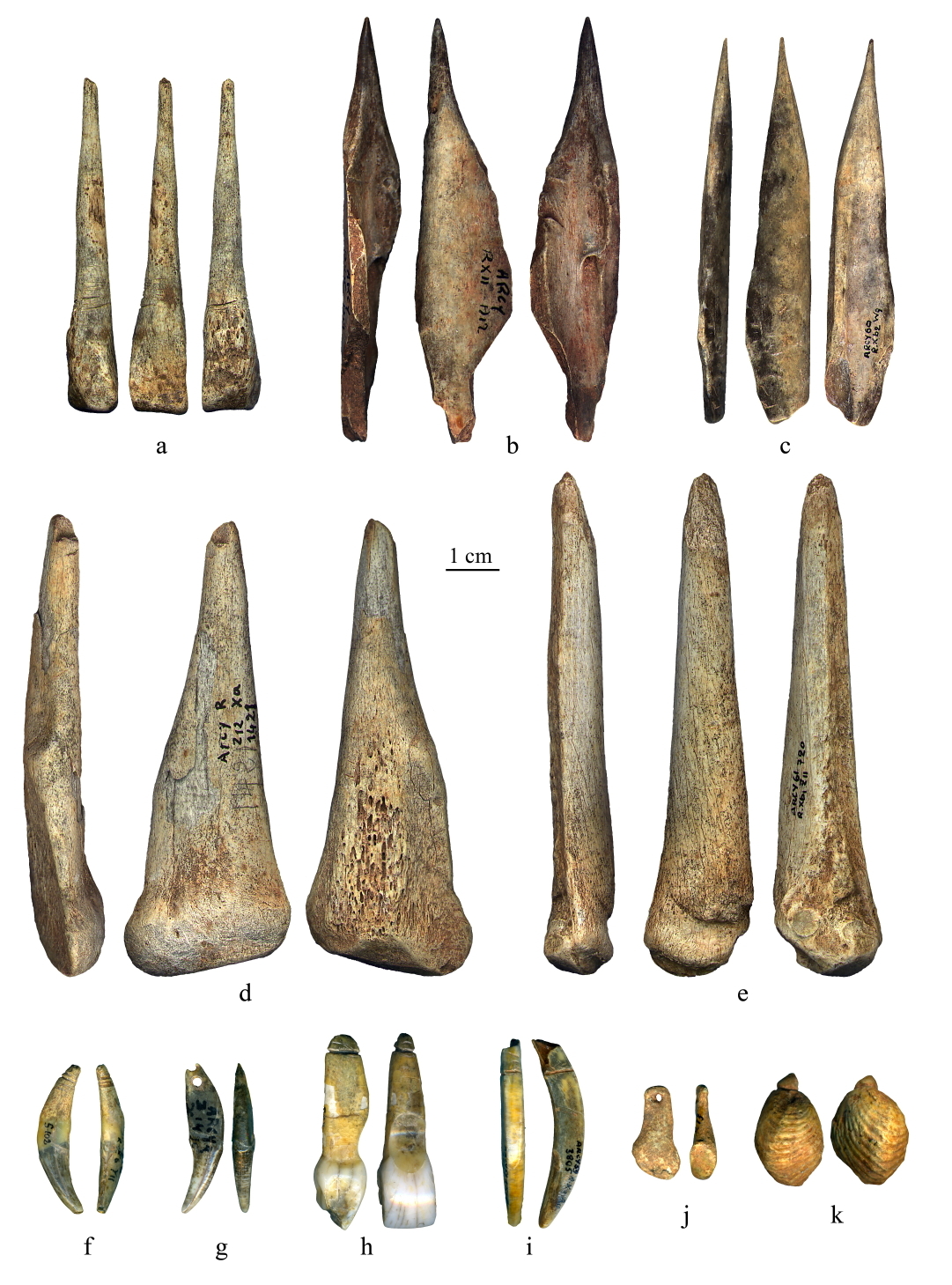
Neanderthals and ornaments:
AMS
dating of the Grotte du Renne, France
The theory that later Neanderthals might have been sufficiently
advanced to fashion jewellery
and tools similar to those of incoming modern humans has suffered a
setback. A new radiocarbon dating study, led by the ORAU, has found
that an archaeological site that uniquely links Neanderthal remains to
sophisticated tools and jewellery may be partially mixed. The study, published in PNAS,
suggests that the position of key finds in the archaeological layers of
the Grotte du Renne at Arcy-sur-Cure in France may not be trustworthy.
A large series of new ultrafiltered bone radiocarbon dates were
obtained from a range of cutmarked bones and artefacts from several
layers through the site. The Bayesian analysis of the results suggested
that around 1/3 of the results were statistical outliers, raising
questions over the association of the Neanderthal human remains and the
personal ornaments (some pictured above) found in the
same
archaeological layers.
Lead author Dr Tom Higham said: ‘Our
results confirm that
material has moved up and down and is out of sequence in the
Châtelperronian levels. We think that there has probably been
some physical disturbance which has disrupted the proper sequence of
the layers. This means that any chronological interpretation from this
site should be viewed with caution'.
‘Our
study raises questions
about the link between
Neanderthals and the tools and jewellery found in the
Châtelperronian levels. This site is one of only two in the
French Palaeolithic that seems to show a link between ornaments and
Neanderthal remains. This has previously been interpreted as indicating
that Neanderthals were not intellectually inferior to modern people but
possessed advanced cognition and behaviour. Our work says there is a
big question mark over whether this link exists.’
Press
coverage of this story:
(Oxford University: "New
Study questions whether Neanderthals made jewellery after all")
Science
Science
now
Los
Angeles Times
The
Observer
Planet
Earth
The original article is published on PNAS, here:
Higham
et al. 2010 PNAS article
Commentary
on the paper in PNAS by PA Mellars
05/05/2010
 |
 |
 |
Samples
of papyrus, independently dated
to the Egyptian historic chronology,
were amongst samples analysed in the research. |
Saqqara,
the step pyramid, produced
material dating to the ruler Old Kingdom
ruler Djoser, was selected for dating. |
Short-lived
samples of seeds and plant
materials used in the research published
in Science. |
Science paper -
Radiocarbon-based chronology for Dynastic Egypt
Research by an international team led by staff at the ORAU has mapped
out an accurate chronology of the kings of ancient Egypt using
radiocarbon analysis of short-lived plant remains from the region. The
research has now been published in the journal Science
(18 June, 2010).
The research sheds light on one of the most important periods of
Egyptian history documenting the various rulers of Egypt’s
Old,
Middle and New Kingdoms. Despite Egypt’s historical
significance,
in the past the dating of events has been a contentious undertaking
with Egyptologists relying on various different chronologies.
The radiocarbon dating provides some resolution on the dates and nails
down a chronology that is broadly in line with previous estimates.
However, the new dating evidence does rule out some chronologies that
have been put forward – particularly in the Old Kingdom,
which is
shown to be older than some scholars thought. For example, in the Old
Kingdom, Djoser, one of the best known pharaohs of the Third Dynasty of
Egypt, is thought to have commissioned the first of the pyramids, was
found to have ruled from between 2691 and 2625 BCE, about 50-100 years
earlier than some experts thought. The study also suggests that the
start of the New Kingdom might be pushed back slightly to between 1570
and 1544 BC.
The research has implications for the whole region because the Egyptian
chronology anchors the timing of historical events in neighbouring
areas tied to the reign of particular Egyptian kings. The results will
allow for more historical comparisons to be made in countries like
Libya and Sudan, which have conducted radiocarbon dating techniques on
places of archaeological interest in the past.
Researchers from the Universities of Oxford and Cranfield in the UK,
along with a team from France, Austria and Israel, radiocarbon dated
more than 200 various plants from museum collections from all over the
world, including the Ashmolean and the Pitt Rivers. They used OxCal,
the computer programme devised by Professor Christopher Ramsey (the
leader of the Oxford team) that provides a radiocarbon calibration and
analysis of archaeological and environmental chronological data. Oxford
student Michael Dee combined the dates for the seeds, baskets,
textiles, plant stems and fruit, which were all directly associated
with the reigns of particular ancient Egyptian kings, with historical
information about the order and length of each ruler to create the full
chronology.
The team also undertook research on environmental samples from the
Oxford University Herbaria and found minor differences in radiocarbon
levels in the region – important information for future
dating
studies.
The publication was widely reported in the press:
BBC
news
Nature
Science
aboutarchaeology.com
Daily
Mail
You can access the paper in Science here:
Radiocarbon-Based
Chronology for Dynastic Egypt, Bronk Ramsey et al. 2010.
05/05/2010
Antiquity prize
Every year the Antiquity Prize is awarded for the best article
published in the journal Antiquity,
and the Ben Cullen Prize is awarded for the runner up.
This year the panel of judges decided to award the 2009 Ben Cullen
Prize and £500 to the article ‘A new chronological
framework for prehistoric Southeast Asia based on a Bayesian model from
Ban Non Wat', by Charles and Tom Higham.
29/04/2010
BBC Filming
A film crew from the BBC has
been in the laboratory filming
sequences and interviews for a forthcoming series on the prehistory of
the British Isles. The first programme focuses on the Early Upper
Palaeolithic, with the 'Red Lady' of Paviland a central theme. The
remains of the 'Red Lady' (actually a man) were excavated by William
Buckland in 1823. They are earliest formal buried remains of a modern
human in Britain. In 2007, the bones were redated at the lab and
produced ages which were earlier than previously determined, at around
29, 000 BP. A paper on the results was published by Roger Jacobi and
Tom Higham in 2008 in the Journal of
Human Evolution.
Neil Oliver, from the BBC's
'Coast' series is the presenter of the
programmes, which will screen in 2011.
 |
 |
 |
| Martin
and Phil with lights in the AMS control room. |
Neil
Oliver meeting Angela and Barbara. |
Jane
drilling bones. |
20/03/2010

Radiocarbon Dating &
Egyptian Chronology Symposium
The results of a Leverhulme
Trust-funded project into the chronology of Ancient Egypt
were the
subject of a recent 2-day symposium in Oxford. The meeting was the
culmination of a 3-year research programme undertaken by the Egyptian
Chronology Project team based at the ORAU. The study included a new
series of radiocarbon measurements on Egyptian material from
collections held in Europe and the USA. The overall aim was to examine
the consistency of the Egyptian chronology with dates obtained via the
radiocarbon method.
An empty gallery on the upper
levels of the newly-refurbished
Ashmolean Museum served as the venue for the symposium. The schedule
began with introductory talks by Christopher Ramsey (ORAU) and Andrew
Shortland (Cranfield), a duo who later that day also presented a public
lecture on the subject at the University Museum of Natural History. The
first sessions of the conference covered the key methodological
considerations involved in radiocarbon dating items from ancient Egypt.
After this, the focus shifted to the chronology of the main Kingdoms of
the Dynastic period, with the new radiocarbon evidence providing the
backdrop for each session. The presentations continued with sessions on
the Early Dynastic and Third Intermediate Periods, where more
scientific investigation is planned, and concluded with a lively
discussion on the main themes of the conference.
In all, the meeting proved very
fulfilling and highly informative.
By bringing together experts from museums, Egyptology departments,
radiocarbon and conservation laboratories the implications of the
research were able to be thoroughly scrutinized. A publication of the
proceedings is planned in due course.
 |
 |
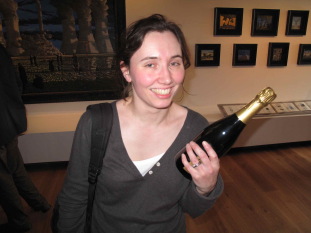 |
At
the Eagle and Child pub after the second day of the
conference.
Mark Lehner (front left) and Ken Kitchen (right) and others. |
David
Warburton, Mark Lehner and Jo Rowland. |
Fiona
Brock (ORAU) (with bubbly for organising the
meeting..). |
11/02/2010
Nature
publication
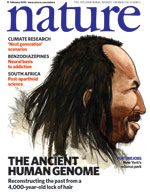 |
ORAU staff co-authored a recent paper in the journal Nature.
The sequence of a near-complete nuclear genome was been obtained from
the tissue of a male palaeo-Eskimo from southern Greenland. ORAU dated
the human remains to ~4,000 years ago. The genomic DNA was found in a
permafrost-preserved lock of hair and the DNA work was spearheaded by
Eske Willerslev and colleagues at the Centre for GeoGenetics at the
University of Copenhagen. The research was reported widely in the
press.
|
16/06/2009
20th International Radiocarbon
Conference 2009, Big Island, Hawaii

The 20th International Radiocarbon conference was held in Kona, Hawaii
- (on the Big Island), in June
2009. The meeting was well attended by ORAU staff and students with
(left to right) Anat Marom-Rotem, Tom Higham, Katerina
Douka, Christopher Ramsey, Richard Staff, Rachel Wood
and
Mike Dee all giving papers.
Talks given included:
- Radiocarbon dating the
dispersal of the first anatomically modern
humans into western Europe (Higham et al).
- Radiocarbon dating of the
first European modern humans: new
direct AMS dates of Aurignacian shell ornaments (Douka et al.)
- The impact of new
radiocarbon pretreatment techniques for
understanding the Iberian Middle to Upper Paleolithic transition (Wood
et al.)
- Suigetsu 2006: a wholly
terrestrial radiocarbon calibration curve
(Staff et al.)
- Developments in the
calibration and modeling of radiocarbon dates
(Bronk Ramsey et al.)
- Development of a new
analytical method for radiocarbon dating
bones using the amino acid hydroxyproline (Marom et al.)
- A new 14C chronology for New
Kingdom Egypt (Dee et al.)
- Improved AMS radiocarbon
dating of shell carbonates using
high-precision XRD and density separation (Douka et al.)
Posters included:
- Method development for very
small mass samples at the Oxford
Radiocarbon Accelerator Unit (Staff et al.)
- The utility of
Chromosorb® for monitoring contamination
during 14C pretreatment (Dee et al.)
- Refining the pretreatment
background correction of collagen
extracted by ultrafiltration at ORAU (Wood et al.)
- Radiocarbon dating and
diet-derived offsets from geothermal
sourced freshwater systems: a case study from the archaeological site
of Klin Yar, Russian North Caucasus (Higham and Wood).
ORAU/RLAHA staff and students also contributed to other presented work
at the
conference:
- Hydropyrolysis: implications
for radiocarbon pretreatment and
black carbon quantification (Ascough, Wood, Higham, Brock).
- A new pretreatment method
for molluscan shell using density
fractionation of carbonates in bromoform (Tripp, Douka, Higham).
- A wiggle-matched date for
the Copper Age cemetery at Manerba del
Garda, Northern Italy (Barfield, Higham).
- An investigation into the
hardwater effect and its influcence on
reliable estuarine radiocarbon determinations from Aotea Harbour, New
Zealand (McKinnon, Higham).
- Assessment of the integrity
of the Southern Hemisphere 14C
calibration curve and its extension from AD 785 to 195 BC, with
particular emphasis on the interhemispheric offset (Hogg, Bronk Ramsey).
- Progress in the extension
and update of the IntCal04, Marine04,
and SHCal04 radiocarbon calibration curves (Reimer, Bronk Ramsey).
- A nondestructive
prescreening method for bone collagen content
using microcomputed tomography (Tripp, Hedges)
- A new method for correcting
the marine reservoir effect on
radiocarbon age of human remains based on nitrogen isotopic
compositions of individual amino acids in collagen (Naito, Yoneda,
Honch).
- Lake Suigetsu –
2006: a novel approach to varve counting:
combining thin section microscopy and microXRF and radiography
(Scholaut, Bronk Ramsey et al).
- High-resolution inter-basin
chronology of Holocene paleoseismic
events at the Dead Sea Basin by a Bayesian radiocarbon deposition model
(Kagan, Bronk Ramsey).
29/10/2008
Radiocarbon dating of Khirbat
en-Nahas
ORAU staff Tom Higham and Christopher Bronk Ramsey have been working
with archaeologist Professor Tom Levy (Univ. California-San Diego) for
the last 5 years applying high-precision radiocarbon dating methods to
sites in Jordan dating to the Iron Age. The results are very important
for understanding the synchronisms between purported historical
figures, such as those mentioned in the Hebrew Bible, and
archaeological sites and sequences. One key site is Khirbat en-Nahas, a
large copper mine in the Wadi Faynan. Recent results, published
today in the Proceedings of
the National Academy of Science of the US (PNAS) demonstrate
major smelting activities in this, the region of biblical Edom
(southern Jordan) during the 10th and 9th centuries BCE. A sequence of
high-precision radiocarbon dates produced here in Oxford push back by 2
centuries the accepted Iron Age chronology of Edom and show that
industrial-scale metal production was being practised at a time when
there were significant political events taking place nearby in ancient
Israel. Levy's team, co-directed by Jordanian archaeologist Mohammad
Najjar, found two ancient Egyptian stone and ceramic artefacts amongst
the deep excavation, clues that may link the site with the invasion of
Israel by the Egyptian pharoah Shoshenq 1 in the late 10th century BCE.
The research was reported widely in the press.
Some links:
10/07/2008
Royal Society honours Oxford
researchers
Professor Robert Hedges, Deputy
Director of the Laboratory of
Archaeology and the History of Art at Oxford has been awarded a Royal
Medal for his contribution to the rapid development of accelerator mass
spectrometry and radiocarbon dating techniques.
His research focuses on the
recovery of information about human and
animal diets, and ancient environments, from archaeological sites. This
work includes identifying surviving biological molecules and
understanding how such molecules degrade over time.
22/03/2008
Shroud of Turin Broadcast on
BBC2
Christopher Ramsey, director of
ORAU has been working with a
team from Performance Films Ltd making a documentary about the Shroud
of Turin for the BBC. The film (transmitted on BBC2 at 8:30pm
on
22nd March) examined the evidence for the authenticity of the
Shroud. It also marked the 20th anniversary of the original
carbon dating completed by the Zurich, Arizona and Oxford radiocarbon
laboratories. All three labs gave a consistent,
mediaeval
date for the Shroud.
The Oxford Radiocarbon
Accelerator Unit collaborated in tests of a
new hypothesis, put forward by John Jackson, of the Turin Shroud Center
of Colorado in the United States, suggesting that the Shroud might over
time have been contaminated with carbon monoxide which is naturally
enriched in radiocarbon. Dr. Jackson was the leader of a 30
person scientific team from the United States that conducted a 5-day
scientific study of the Shroud in 1978. What is significant
in
this particular hypothesis is that only a 2% carbon contamination from
carbon monoxide is needed to move the mediaeval radiocarbon date of the
Shroud to First Century. In this collaboration, the Colorado
team
is responsible for preparing test samples of modern linen exposed to
carbon monoxide. Oxford is responsible for determining if
contamination has actually occurred in the samples using mass
spectrometry.
In the past carbon monoxide has
not been thought of as a likely
contaminant because it is chemically relatively inert. The
initial tests showed that in normal conditions there is no
contamination at the level needed to alter radiocarbon dates at
all. Thus as yet, there is no direct evidence that the
original
radiocarbon measurements were not accurate. We have yet to
test
whether there is anything in the specific storage conditions of the
Shroud which might affect this conclusion.
Further research on the Shroud
is certainly needed: it is important
that we continue to investigate anything that might have affected the
accuracy of the original radiocarbon tests. It is equally
important that other experts critically assess and reinterpret all the
evidence which may point to an earlier date. Only by doing
this
will we be able to arrive at a coherent history of the Shroud which
takes into account and explains all the available information.
Further information...
26/10/2007
Online database goes live
An online searchable database
of ORAU
dates has now gone live. This enables you to search for sites by
region, site name or OxA number. This gives public access to all dates
published in datelists or elsewhere.
Submitters can now also fill
sample submission forms in online and
track the results of their analyses through the lab and get details of
chemical pretreatement. If submitters wish to have this information for
past projects they should contact the lab and this can be arranged.
The database also allows anyone
to check
an OxA number against
our database. If you have the OxA number for a date you can check which
instrument it what measured on, when and by what method and the actual
date and uncertainty. This applies to all dates published and
unpublished.
13/09/2007
Book Cited for Scholarly Impact
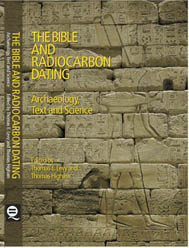 |
Tom Higham has received
the 2007 award for the best scholarly
book on archaeology by the Biblical Archaeology Society, as co-editor
of the book “The Bible and Radiocarbon Dating: archaeology,
text
and
science”.
In citing Higham and his
co-author Dr Tom Levy, Professor of
Anthropology at the University of California at San Diego, judges for
the award said the book is “critical, timely, well-produced
and
sure to
have an immediate impact on the field.”
In a further description
of the work, the award committee
wrote, “The volume leaves no doubt that in light of these
advances
every excavator must incorporate [radiocarbon dating] into his or her
research design.”
The 2007 Biblical
Archaeology Society Publication Awards
recognize the best books on archaeology and the Bible published in 2005
and 2006 and have been presented since 1985. The book comprises 27
chapters which stemmed from an invited meeting in Oxford organised by
Levy and Higham in 2004.
|
01/11/2006
OxCal4 Released
This is a completely new
version of OxCal - a program which can be
used for radiocarbon calibration and more general analysis of
chronological information. The new version differs from version 3 in a
number of ways:
- It is web-based and so can
be used online without installation
(assuming you have a suitable browser)
- Standalone versions are
available for PC and Mac platforms
- The program incorporates
many new modelling tools - including
methods for age-depth modelling
- Post-bomb calibration is now
possible
- All graphics are in the SVG
(scalable vector graphics) format
For further information and
access to the program see the OxCal
section of this website.
01/9/2006
NERC grant obtained
Substantial funding for a three-year research programme concerned with
the Middle and Upper Palaeolithic of Europe has been obtained in the
latest round of NERC standard research grants. The project is led by
Tom Higham, Roger Jacobi (British Museum), Christopher Bronk Ramsey and
William Daavies (now at Southampton University). Work undertaken at
ORAU over the last 4-5 years has shown that significant improvements
can be achieved in the AMS dating of Palaeolithic bone when using
ultrafiltration during collagen extraction. Previous work has been
predominantly focussed upon the British Palaeolithic, and this grant
will extend the work to key French, German and Spanish
sequences.
07/04/2006
19th International Radiocarbon
Conference
The 19th
International Radiocarbon Conference
was held in Keble College, Oxford from the 3rd-7th April 2006, hosted
by the Oxford Radiocarbon Accelerator Unit. The programme included
sessions on:
- Archaeology
- Calibration
- Palaeolithic Chronology
- Exotic applications of
Radiocarbon
- Accelerator Mass Spectrometry
- Sample preparation
- Bayesian analysis
- Earth systems and climate
- Marine applications
- Terrestrial applications
There was a key-note address by
Prof Lord Renfrew on the first day
of the conference.
10/12/2005
Grant from the Leverhulme
Trust obtained
We are pleased to announce that
a substantial grant from the
Leverhulme Trust has been obtained to investigate questions surrounding
the Egyptian historic chronology and the reliability of radiocarbon
dating of material from Egyptian archaeological contexts. The project
was conceived by Christopher Bronk Ramsey, Tom Higham (ORAU) and Andrew
Shortland (formerly RLAHA now Cranfield University, Shrivenham). The
project team also includes Dr Stephen Harris (Oxford), Dr Ian Shaw
(Liverpool) and Dr Fiona Brock (ORAU), as well as international
collaborators Dr Ezra Marcus (Haifa), Dr Sturt Manning (Cornell) and
Prof Walter Kutschera (Vienna). A D.Phil student (Michael Dee) has just
joined the project, which runs over the next three years.
9/7/2004
ARHC to contribute funding to
the ORADS programme
We are extremely pleased to
announce that from December 2004, the
Arts and Humanities Research Board (ARHC,
will be contributing funding to ORADS (Oxford Radiocarbon Dating
Accelerator Service). This will widen the dating service to the British
archaeological community to embrace more fundamentally archaeological
projects requiring AMS radiocarbon dating. NERC/ARHC's ORADS panel will
meet biannually to award funding for AMS dating at Oxford.
05/11/2003
International Radiocarbon
Conference 2006
We are very pleased to be able
to announce that the 19th
International Radiocarbon Conference will be hosted by ORAU in Oxford
in spring or autumn of 2006. We will announce further details
on
the conference
web site.
01/10/2003
New director and deputy
director for ORAU
Dr Christopher Bronk Ramsey
took over from Prof Robert Hedges as
Director of ORAU. Robert Hedges had led the lab for about 25
years and is now going to concentrate on other aspects of his
research. Fortunately for ORAU, as he remains within the
Research
Lab for Archaeology, he will still be able to give valuable advice on
radiocarbon dating, stable isotope research etc..
Christopher Bronk Ramsey has
been the Deputy Director of ORAU for
the last few years with particular responsibilities for the new AMS
facility. Originally a physicist, he has a wide range of
interests in radiocarbon, from archaeological applications (such as the
chronology of the eastern Mediterranean) to GC-AMS and radiocarbon
calibration (as the author of OxCal).
Tom Higham has now taken over
as Deputy Director of ORAU. He
joined the lab a couple of years ago having been Deputy Director of the
Waikato Radiocarbon Laboratory in New Zealand. Tom is an
archaeologist with over 15 years experience in many technical aspects
of radiocarbon dating. He has written many papers on the
subject
and is the founder of the award winning Radiocarbon WEB Info.
01/09/2003
International Radiocarbon
Conference 2003
This conference was held in
Wellington, New Zealand. Robert
Hedges, Christopher Bronk Ramsey and Tom Higham attended the conference
and presented nine papers:
- Towards High Precision AMS:
Progress and Limitations (Bronk
Ramsey and Higham)
- Improvements to the
pre-treatment of bone at Oxford (Bronk
Ramsey, Higham, Bowles and Hedges)
- Using a gas ion source for
Radiocarbon AMS and GC-AMS (Bronk
Ramsey, Humm, Leach)
- Dating the Volcanic Eruption
at Thera (Bronk Ramsey, Manning and
Galimberti)
- AMS dating latest
Neanderthal occupation layers on Gibraltar
using marine shell (Cheney, Higham, Ditchfield Barton, Stringer,
Finlayson, Rhodes, Bronk Ramsey)
- Wiggle-Match dating of
tree-ring sequences (Galimberti and Bronk
Ramsey)
- Problems associated with the
AMS dating of small bone samples:
the question of the arrival of Polynesian rats to New Zealand (Higham,
Hedges, Anderson, Bronk Ramsey)
- A pre-treatment procedure
for the AMS radiocarbon dating of
sub-fossil insect remains (Higham, Tripp and Hedges)
- Differentiating bone
osteonal turnover rates by density
fractionation; validation using the bomb 14C
atmospheric
pulse (Shin and Hedges)
and contributed to a
further six:
- Radiocarbon and stable
isotope evidence of dietary change from
the Mesolithic to the Middle Ages in the Iron Gates: New results from
Lepenski Vir (Cook et al)
- Extension and Revision of
the radiocarbon calibration dataset:
Part 2 IntCal04 beyond tree rings 26.0 - 12.4 ka cal BP (Hughen et
al)
- Lugovskoe, Western Siberia:
a possible extra-Arctic mammoth refugium
at the end of the Late Glacial (Orlova et
al)
- COMPARE04 -
Comparison/Calibration 14C
records
26-50k (van der Plicht et al)
- An inter-laboratory
radiocarbon study of the southern Levant
(Wild et al)
- Rats by proxy: dating the
arrival of rattus exulans
to
New Zealand (Wilmshurst and Higham)
September 2002
New AMS commissioned at ORAU
A new AMS capable of much
higher precision measurements, built by
HVEE, started routine measurements. The acquisition of this
instrument and its supporting infrastructure was the main component of
ORAU's Joint Infrastructure Fund (JIF) grant from NERC.






















